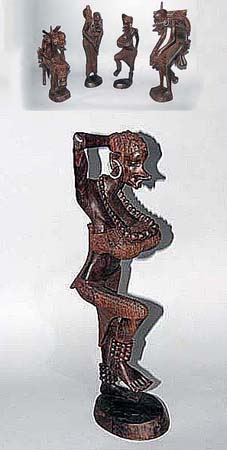
Owner: HWMC
Catalog#: AF-OTHR-20
Ritual Symbolism
Makonde 'Dancer' (B)
Southeast Tanzania and Northern Mozambique
Makonde
Grenadilla, metal ear loops
Late 20th century
Height: 13.5 in
Other – Ritual Symbolism
Engraved/signed on bottom: M. ATUPALI 95
According to the African Blackwood Conservation Project, “One of the richest and most emotive cultural expression of the interplay between Dalbergia melanoxylon (African blackwood, Grenadilla, or mpingo) ) and its human users, is the ever-evolving dynamic seen in the work of the Makonde carvers of Mozambique and Tanzania.” The traditions of these African artists reach back in time prior to the late 1400s, when Portugal governed the region known as Mozambique. The Makonde are of Bantu origin, and it is thought they migrated from the west into southern Tanzania and northern Mozambique during the 17th and 18th century to escape Arab and colonial slave traders, and the predation of other tribes. Customary was the practice of ‘keloid’ (body scarification) as a means of identification and as seen in the detail carvings of these hand carved statues.
At first the Makonde carvings were for ritual functions, a part of their cultural practices. During the early 20th century, they became an art form for Portuguese buyers, serving as economic revenue to help the Makonde people reduce the tax burdens of the colonial system.
During the 20th century the Makonde artisans developed three distinctive forms of expression: Binadamu – the depiction of realistic human and animal figures; Ujamaa – an expression of human connectedness and interdependence; and Shetani – imaginative carvings depicting their spirit world.
Seen here is the Binadsmu form depicting a set of two women dancers and two male drummers. Beautiful detail carving, each from one piece of African Grenadilla.
Reference: Makonde Art – African Blackwood Conservation Project
